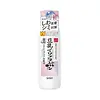What's inside
What's inside
 Key Ingredients
Key Ingredients

 Benefits
Benefits

 Concerns
Concerns

 Ingredients Side-by-side
Ingredients Side-by-side

Arbutin
AntioxidantDipotassium Glycyrrhizate
HumectantWater
Skin ConditioningGlycerin
HumectantDipropylene Glycol
HumectantLactobacillus/Soymilk Ferment
HumectantGlycine Soja Extract
Skin ConditioningButylene Glycol
HumectantAlcohol Denat.
AntimicrobialCitric Acid
BufferingSodium Citrate
BufferingStyrene/Va Copolymer
Polyethylene
AbrasivePolyglyceryl-3 Hydroxypropyl Ethylhexyl Ether
CleansingPhenoxyethanol
PreservativeSodium Paraben
PreservativeArbutin, Dipotassium Glycyrrhizate, Water, Glycerin, Dipropylene Glycol, Lactobacillus/Soymilk Ferment, Glycine Soja Extract, Butylene Glycol, Alcohol Denat., Citric Acid, Sodium Citrate, Styrene/Va Copolymer, Polyethylene, Polyglyceryl-3 Hydroxypropyl Ethylhexyl Ether, Phenoxyethanol, Sodium Paraben
Niacinamide
SmoothingWater
Skin ConditioningButylene Glycol
HumectantGlycerin
HumectantPentaerythrityl Tetraethylhexanoate
EmollientAlcohol Denat.
AntimicrobialTrimethylpyrazine
PerfumingLactobacillus/Soymilk Ferment Filtrate
Skin ConditioningRetinol
Skin ConditioningN-Stearoyl-Dihydrosphingosine
Skin ConditioningCyclodextrin
AbsorbentCarbomer
Emulsion StabilisingXanthan Gum
EmulsifyingGlycerin Methyl Ether
Sorbitan Fatty Acid Ester
EmulsifyingGellan Gum
Glycine Soja Seed Extract
Skin ConditioningCaprylic/Capric Triglyceride
MaskingPhytosterols
Skin ConditioningSodium Lauryl Phosphate
EmulsifyingHydrogenated Castor Oil
EmollientSorbitan Isostearate
EmulsifyingPolysorbate 20
EmulsifyingPotassium Oxide
BufferingSodium Hydroxide
BufferingHydrogenated Phosphatidylcholine
EmulsifyingPhenoxyethanol
PreservativeNiacinamide, Water, Butylene Glycol, Glycerin, Pentaerythrityl Tetraethylhexanoate, Alcohol Denat., Trimethylpyrazine, Lactobacillus/Soymilk Ferment Filtrate, Retinol, N-Stearoyl-Dihydrosphingosine, Cyclodextrin, Carbomer, Xanthan Gum, Glycerin Methyl Ether, Sorbitan Fatty Acid Ester, Gellan Gum, Glycine Soja Seed Extract, Caprylic/Capric Triglyceride, Phytosterols, Sodium Lauryl Phosphate, Hydrogenated Castor Oil, Sorbitan Isostearate, Polysorbate 20, Potassium Oxide, Sodium Hydroxide, Hydrogenated Phosphatidylcholine, Phenoxyethanol
Ingredients Explained
These ingredients are found in both products.
Ingredients higher up in an ingredient list are typically present in a larger amount.
Alcohol Denat. is an alcohol with a denaturant property. It is created by mixing ethanol with other additives.
This ingredient gets a bad rep because it is irritating and drying - mostly due to its astringent property. Astringents draw out natural oils in tissue, constricting pores and leaving your skin dried out.
However, alcohol denat. is not all that bad.
Due to its low molecular weight, alcohol denat. tends to evaporate quickly. One study on pig skin found half of applied alcohol evaporated in 10 seconds and less than 3% stayed on skin.
This also helps other ingredients become better absorbed upon application.
Studies are conflicted about whether this ingredient causes skin dehydration. One study from 2005 found adding emollients to propanol-based sanitizer decreased skin dryness and irritation. Another study found irritation only occurs if your skin is already damaged.
Small amounts of alcohol are generally tolerated by oily skin or people who live in humid environments.
The rule of thumb is if this alcohol is near the end of an ingredients list, it will probably not affect your skin much.
Also...
This ingredient has antimicrobial and solvent properties.
The antimicrobial property helps preserve products and increase their shelf life. As a solvent, it helps dissolve other ingredients.
Other types of astringent alcohols include:
Learn more about Alcohol Denat.Butylene Glycol (or BG) is used within cosmetic products for a few different reasons:
Overall, Butylene Glycol is a safe and well-rounded ingredient that works well with other ingredients.
Though this ingredient works well with most skin types, some people with sensitive skin may experience a reaction such as allergic rashes, closed comedones, or itchiness.
Learn more about Butylene GlycolGlycerin is already naturally found in your skin. It helps moisturize and protect your skin.
A study from 2016 found glycerin to be more effective as a humectant than AHAs and hyaluronic acid.
As a humectant, it helps the skin stay hydrated by pulling moisture to your skin. The low molecular weight of glycerin allows it to pull moisture into the deeper layers of your skin.
Hydrated skin improves your skin barrier; Your skin barrier helps protect against irritants and bacteria.
Glycerin has also been found to have antimicrobial and antiviral properties. Due to these properties, glycerin is often used in wound and burn treatments.
In cosmetics, glycerin is usually derived from plants such as soybean or palm. However, it can also be sourced from animals, such as tallow or animal fat.
This ingredient is organic, colorless, odorless, and non-toxic.
Glycerin is the name for this ingredient in American English. British English uses Glycerol/Glycerine.
Learn more about GlycerinPhenoxyethanol is a preservative that has germicide, antimicrobial, and aromatic properties. Studies show that phenoxyethanol can prevent microbial growth. By itself, it has a scent that is similar to that of a rose.
It's often used in formulations along with Caprylyl Glycol to preserve the shelf life of products.
Water. It's the most common cosmetic ingredient of all. You'll usually see it at the top of ingredient lists, meaning that it makes up the largest part of the product.
So why is it so popular? Water most often acts as a solvent - this means that it helps dissolve other ingredients into the formulation.
You'll also recognize water as that liquid we all need to stay alive. If you see this, drink a glass of water. Stay hydrated!
Learn more about Water